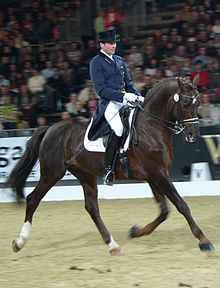Grand Prix Dressage

An upper-level dressage competitor performing a working trot
|
|
| Highest governing body | International Federation for Equestrian Sports (FEI) |
|---|---|
| Characteristics | |
| Contact | No |
| Team members | Individual and team at international levels |
| Mixed gender | Yes |
| Equipment | Horse, appropriate horse tack |
| Venue | Arena, indoor or outdoor |
| Presence | |
| Country or region | Worldwide |
| Olympic | 1912 |
| Paralympic | 1996 |
Dressage (/ˈdrɛsɑːʒ/ or /drᵻˈsɑːʒ/; a French term, most commonly translated to mean "training") is a highly skilled form of riding performed in exhibition and competition, as well as an "art" sometimes pursued solely for the sake of mastery. As an equestrian sport defined by the International Equestrian Federation, dressage is "the highest expression of horse training" where "horse and rider are expected to perform from memory a series of predetermined movements."
Competitions are held at all levels from amateur to the Olympic Games and World Equestrian Games. Its fundamental purpose is to develop, through standardized progressive training methods, a horse's natural athletic ability and willingness to perform, thereby maximizing its potential as a riding horse. At the peak of a dressage horse's gymnastic development, the horse responds smoothly to a skilled rider's minimal aids. The rider is relaxed and appears effort-free while the horse willingly performs the requested movement.
The discipline has a rich history with ancient roots in the writings of Xenophon. Modern dressage has evolved as an important equestrian pursuit since the Renaissance when Federico Grisone's "The Rules of Riding" was published in 1550, the first treatise on equitation in over a thousand years since Xenophon's On Horsemanship. Much about training systems used today reflects practices of classical dressage.
...
Wikipedia
